By Bus & Rail
Trial by fire for Metro’s new top cop
February 6, 2014
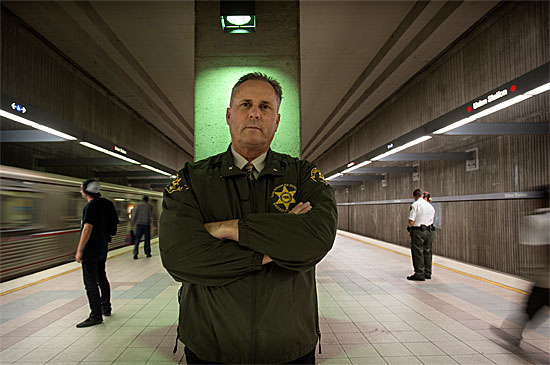
Commander Claus is a SWAT veteran with a dramatically different set of new responsibilities at Metro.
Sheriff’s Commander Michael Claus became the new head of security for Metro’s bus and rail system on January 6. He knew the job would be complicated, but he couldn’t have predicted what would happen next.
A week after he started, on the morning of January 13, a fatal stabbing took place on the Red Line. It was the second killing in the history of the line, and the widely-publicized tragedy forced Claus to throw out his playbook.
“If you can imagine taking a big, giant eraser board that has everything laid out nice and neat, and then just take both hands and move everything around? That’s what it was like,” Claus said.
Luckily, his police instincts kicked in.
“When something like this occurs, you have two issues,” Claus said. “One, you have to solve the problem, find out who did it and hopefully have an arrest—which we did. Second, as an administrator you have to look at what we did, whether we could have prevented it and what we can do now to prevent it in the future. You have to wear two hats.”
The first part comes naturally for Claus, 52, who has more than 33 years of experience as a Los Angeles County Sheriff’s Department deputy, SWAT team member and SWAT commander. The administrative part is new territory.
“I left my dream job,” Claus said. “When I was a deputy at SWAT, I always said I wanted to be the first person to work on the unit and then go back and command the unit. And I was the first person to do that. Eight months later I get a phone call and the sheriff asked me to come over here and command this bureau. You don’t tell the sheriff ‘no.’ ”
After decades on patrol, Claus now finds himself doing much of his work from behind a desk.
“This is completely different from anything I’m used to,” he said.
One immediate challenge has been managing public perceptions in the wake of the stabbing, which raised safety concerns among many transit riders. Claus said those fears are understandable, but they’re distorted by this isolated event, in part because of how the media covered it. “It’s like a plane crash,” he said. “After a plane crash they tell you it’s the safest transportation mode in the world. But when there’s a murder, the news doesn’t do that.”
According to Sheriff’s Department statistics, “Part 1” crimes, which include homicide, rape, aggravated assaults and theft crimes, are exceedingly rare on Metro’s system. On the Red Line, for example, there were only 3.8 of those crimes per million riders in 2013. Violent crimes are even rarer, with property offenses like the theft of electronic devices accounting for the majority of that number.
Other than a police station parking lot, Metro is one of the worst places to commit a crime. Perpetrators rarely get away because closed-circuit TV cameras are always watching and camera-equipped passengers serve as witnesses, Claus said. The suspect arrested and charged with the Red Line stabbing was identified using footage from train and station cameras.
“If Metro’s system were a city, it would be the safest city in the country,” said Duane Martin, who manages the agency’s work with the Sheriff’s Department. “People tend to focus on occurrences that are out of the ordinary. When something like this happens on Metro, it stands out.”
Still, even one crime is too many for the people charged with protecting the riding public. Claus is already brainstorming improvements. One idea he’s considering is assigning teams of deputies to the same couple of stations or bus stops every day to create a transit version of community policing, enabling the deputies to get familiar with regular patrons—and potential troublemakers. Currently, deputies are generally assigned to regions that they are familiar with and moved around as needs dictate. Claus wants to focus them on smaller beats to give them a proprietary interest in keeping each area safe.
Both Claus and Metro’s Martin are seeking to improve fare enforcement, a major priority for the agency. Currently, deputies are responsible for making sure that people pay their fares and for issuing citations to violators. But Claus believes that sworn deputies’ skills are better used elsewhere.
“From what I’ve seen so far, I think it’s a waste of a resource for a deputy sheriff to check TAP cards,” Claus said. “Deputy sheriffs should be performing law enforcement functions, not revenue functions.” He added that it’s tough to recruit good people because trained police don’t want to spend their days checking cards.
Claus envisions using Metro employees and security assistants to check fares instead, while deputies patrol for safety—a quick call away if a conflict arises. Martin agrees. “When they are on a train and they have both hands checking tickets, they aren’t looking for quality of life issues,” Martin said. With each sworn deputy costing the agency about $210,000 per year and civilian employees costing about a quarter of that amount, “you want to get the best bang for your buck.”
Claus also wants to improve how his team communicates with the public. “We are going to start educating people about how not to be victims,” he said. Part of that involves common sense steps like securing purses and electronic devices. However, in the case of a verbal or physical confrontation, he said, the best course of action is to be a good witness and stay out of the way. “It’s hard for me to say ‘don’t get involved’ because I’m one of those guys that would get involved,” Claus said. But, as a law enforcement officer, he pointed out, “I also carry a gun.”
Suspicious activity, of course, should be reported by dialing 911 or calling the Sheriff’s Department. But there’s a catch. That only works on buses and above-ground light rail; there is currently no cellular or wireless internet service on the subway. There, passengers should look for emergency phones at either end of each rail car and in the stations, or try to find a Sheriff’s deputy or a Metro employee. The agency is in the process of installing wireless service underground, but the effort will not be completed for about a year. “All we have is radio down there,” Martin said. “Having telephone service will be a godsend for us.”
The Sheriff’s Department acts as an independent contractor with Metro, which is paying the department about $83 million for the current fiscal year. The contract expires in June, and Martin expects that the next contract, which must be put through a competitive bidding process, will include new performance standards and different fare enforcement requirements. The current contract started in July, 2009, before TAP cards and gate latching were implemented. Back then, fare enforcement was done mainly by checking individual paper tickets.
Commander Claus hasn’t been on the job long, but he’s adapting quickly to his new position, which also involves delicate political situations he hasn’t faced before.
Because Metro’s territory cuts across many political boundaries, moving resources around can be touchy. “One of the lines may go through one county Supervisor’s district and one goes through another. They might ask ‘why are you taking resources from my district?’”
On top of that, there’s inherent friction between law enforcement’s duty to investigate crimes and Metro’s mission to reliably transport millions of people from place to place on time. Stopping rail lines for lengthy investigations can be a complex undertaking. “You have to find that happy medium,” Claus said.
It all adds up to a brave new world for a man who decided to become a police officer at age 5 while watching cop shows on television. Like any good administrator, his first task will be to take stock of what he already has.
“I love a challenge,” Claus said. “It’s like taking over a factory that makes cars. First you are going to learn how to make the car, and then you’re going to see if you can do anything better.”
Posted 2/6/14
Orange Line’s “dismal” fare findings
January 16, 2014
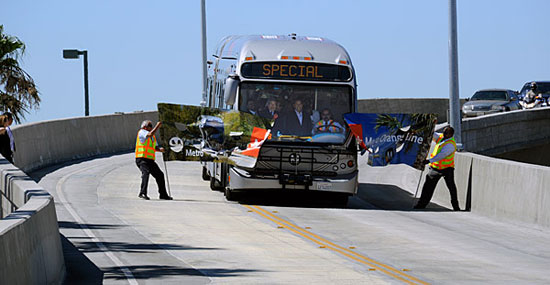
The Orange Line, shown at opening of the busway's extension, is popular but many aren't paying to ride.
Up to 22% percent of Orange Line passengers were deliberate fare evaders and as many as 9% “misused” their TAP cards, according to recent audits assessing the extent of fare-beating on the popular San Fernando Valley dedicated busway.
The findings, presented Wednesday to a Metro committee, are “rather dismal,” acknowledged Duane Martin, the agency’s deputy executive officer for project management.
“We understand there’s no glossing over the significant fare evasion,” Martin said, although he added that the recent redeployment of sheriff’s deputies to check fares along the line has improved the situation.
The Orange Line carries about 30,000 riders a day, and unlike the rest of Metro’s fleet, does not have fare boxes on its buses. Instead, it relies on patrons at un-gated stations to tap their fare cards at machines known as “stand alone validators.”
Many, it appears, have been taking advantage of the system to hitch a free ride.
Two audits—conducted December 3 and December 17—surveyed all patrons as they got off the bus at various Orange Line stations. The first audit, at the North Hollywood, Van Nuys and Sherman Way stations, found 22% fare evasion (traveling without a TAP card or using a card with no value on it) and 9% TAP card misuse (having a valid TAP card but, perhaps inadvertently, failing to properly tap it before entering the bus.) The second audit, at the North Hollywood, Reseda and Canoga stations, found 16% fare evasion and 8% TAP card misuse.
The audits were prompted by a November, 2013, motion by Supervisor Zev Yaroslavsky, a member of Metro’s Board of Directors and a longtime proponent of reforms to help eliminate free riders on the Los Angeles transit system. In a major milestone, gates on the L.A. subway, which for years had operated on the honor system, were finally latched last year. But locking down Metro’s light rail system and the Orange Line, which operates in a similar fashion, is still a challenge.
On Wednesday, Yaroslavsky and another director, Los Angeles City Councilman Paul Krekorian, responded to the Orange Line audit findings with another motion, this one directing Metro staff to explore installing gates at the busway’s stations. They also said that signs explaining that tapping is mandatory (and listing fines for failing to do so) should be placed on or beside the ticket validating machines at the stations.
Moreover, they asked for status reports on gate installation for projects currently being constructed or designed, including phase two of the Expo Line, the Foothill extension of the Gold Line, and the Crenshaw Line.
“Unless we take this issue head-on, and begin to design stations with gates…fare evasion will continue to skyrocket and become a perpetual problem with no end in sight,” the motion said.
“Saturating” the Orange Line with sheriff’s deputies checking fare cards has already started having an impact, including in the period between the first and second audit, Metro deputy executive officer Martin said.
“The deputies are out there so people started tapping again,” he said.
Before Martin reports back to Metro’s board members on the issue in March, he plans to conduct another Orange Line audit, probably next month.
Wiping out all fare evasion is unrealistic, he said, but there is lots of room for improvement. “I would love to be able to operate the system with plus or minus 2% or 3% fare evasion,” Martin said. “That’s the goal.”
Posted 1/16/14
Game on for Bruin, Trojan fare cards
January 15, 2014
The UCLA Bruins and USC Trojans are archrivals on the gridiron, but fans share a common interest: getting to the game in time for kickoff.
To that end, Metro Board members Zev Yaroslavsky (UCLA, Class of ‘71) and Ara Najarian (USC, Class of ‘85) have teamed up on a motion to have the agency develop specially branded Bruin and Trojan TAP cards for travel to home games during the 2014 football season.
There are good light rail alternatives for getting to both teams’ home stadiums; the Expo Line transports USC fans to the Coliseum, and the Gold Line is a shuttle ride away from Pasadena’s Rose Bowl, where the Bruins play. But getting on the train—especially if you don’t already have a TAP card loaded with funds to pay the fare—can cut into the convenience of leaving the driving to Metro.
“Often there are long queues to buy TAP cards and get onto the platform,” the motion said.
Enabling fans to buy a preloaded TAP card at the same time they order tickets through their respective university would “make the whole experience not only more enjoyable, but convenient, efficient and hassle-free,” the motion said.
On Wednesday, Metro’s Finance and Budget committee moved the motion forward to the transit agency’s full board for consideration.
Posted 1/15/14
Metro locks in more revenue
October 17, 2013
Do the math. Taking L.A.’s subway system off the honor system should mean a bump for Metro’s bottom line—and that’s exactly what happened in the first month since gate-latching was completed.
According to Metro’s data for September—the first full month available—revenues have increased by 40% when compared to May, the last month before the lengthy gate latching process started. If that increase holds steady, it would mean an extra $6 million in collected fares each year, said David Sutton, Metro’s deputy executive officer in charge of the project.
“An increase in revenue like this can be put back into the system,” Sutton said. “We can increase our hours of operation, add train cars, we can buy more buses—there is a whole myriad of things we can do with that money.”
Meanwhile, weeding out freeloaders means that ridership on the subway lines has decreased, even as the number of paying customers using TAP cards to gain access to the Red and Purple lines has skyrocketed.
Fare evaders are now unable to freely enter the system and, for the most part, have moved on to other modes of travel, Sutton said, giving paying customers a better ride by improving their security and safety—and by opening up a little more elbow room.
Even with the gates latched, some committed scofflaws will always find ways to game the system, Sutton said. About 19,000 people entered the subway without paying in September, using a variety of tricks or blatantly jumping the gates. Metro is in the process of tweaking the new system to make fare evasion more difficult, and the Sheriff’s Department is issuing citations to catch those who squeeze through.
Nonetheless, in most places the system is working well. During one morning rush hour this week, transit patrons streamed through the gates at the North Hollywood station, tapping in succession as they rushed to catch the next train. At ticket vending machines, fare purchases were made swiftly, with no long lines forming.
A few cyclists were slow getting through, lifting their bikes over the top of turnstiles or, like one young woman, tapping a fare card before pushing through an emergency gate. Sutton said cyclists can currently use the elevator to access the system, but few avail themselves of the option. Metro is planning to add a new gate, similar to the gates for disabled patrons, that will offer cyclists an easier path.
And a few fare-beaters were still trying to get a free ride. One teenager hopped over the gate, singing loudly to the music on his headphones.
But, glitches aside, gate latching has already proved transformative for the transit agency. Metro currently is working to bring some latched gates to its expanding light rail system. While not all stations can be latched due to logistical barriers, Sutton said he believes fare collection will continue to improve as Metro latches some stations along the Gold, Blue and Green lines, an effort scheduled for completion by February, 2014.
More than a million TAP cards are currently active in the system, about twice as many as when ticket vending machines were made TAP-only two years ago.
“If you look at the numbers and you look at the behavior, people are tapping,” he said. “I don’t think we’ve ever had gates; it’s a big behavioral change.”
With the assistance of help phones near entry points, Metro has been able to accomplish that change without having staff present at every station.
“It’s been incredibly smooth—we were expecting a lot more customer pushback,” Sutton said. “The biggest thing I remember is people that would give us a thumbs-up and say ‘it’s about time.’ People that pay want and expect everyone else to pay.”
Posted 10/17/13
Working toward a safer Blue Line
August 29, 2013
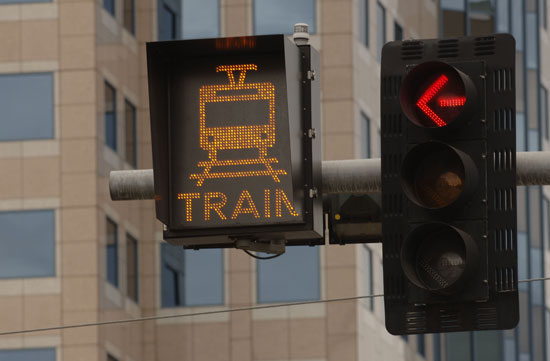
LED signs like this one in Long Beach alert pedestrians to stay off the tracks when a train is coming. Photos/Metro
One year after a task force convened to improve safety on Los Angeles Metro’s Blue Line, newly-released figures show that, while progress is being made, the line remains the deadliest in the system.
Abdul Zohbi, a system safety manager who organized the task force, says every fatality is reason for concern, but that he’s not ready to panic.
“All of our safety projects are being worked on as we speak,” Zohbi said.
Last July, officials discovered a spike in fatalities on the 22-mile light rail line from Downtown Los Angeles to Long Beach. It was on pace to experience the highest number of accidental fatalities and suicides of any year since it opened in 1990.
Acting on a motion by Supervisor Zev Yaroslavsky, Metro’s Board of Directors approved the creation of a Blue Line Task Force to find solutions for the agency’s oldest rail line.
“With our new lines, we are installing state-of-the-art devices that have come into existence in the past 20 years,” said Vijay Khawani, Metro’s executive officer of corporate safety. “A year ago we said, ‘Wait a minute, why can’t we retrofit the Blue Line?’”
Zohbi reached out to the City of Los Angeles’ Department of Transportation, the California Public Utilities Commission and Union Pacific Railroad, which runs a freight line directly alongside the Blue Line. He also invited representatives from Didi Hirsch Mental Health Services, a Culver City nonprofit organization that operates a 24-hour suicide crisis hotline.
The resulting recommendations were approved by the Board last December, and included $7.7 million for such physical improvements as pedestrian gates, bright LED signs and audible warning bell devices, although it has taken time for the measures to work their way through the bureacracy. Additional training is underway for light rail vehicle operators, including 2 days walking the line to experience the environment as pedestrians. And educational outreach to communities, another major part of the new safety program, has begun as well. “We expect the public to do their part in heeding the signs,” Zohbi said.
The outreach and training have already begun, and most of the physical improvements like the new LED signage are expected to be finished by around June of next year. But the improvements Zohbi believes will be most effective—108 new pedestrian gates—must be contracted out competitively, which will take longer.
In the meantime, safety issues continue to plague the Blue Line. According to statistics released Monday, it experienced more accidents and fatalities than all other Metro lines combined since the beginning of 2012, accounting for 56 of 77 accidents involving trains and pedestrians or cars during the period, along with 12 of 14 total fatalities.
“We need a physical barrier to stop people trying to cross the tracks illegally,” Zohbi said. “The No. 1 cause of accidental fatalities on the Blue Line is pedestrians running to catch a train. When you’re trying to save 30 seconds, you could lose your life.”
Tragically, even more deaths are intentional—half of the fatalities in 2012 and 75 percent of deaths so far this year were suicides. The task force called for suicide prevention signs with Didi Hirsch’s 24-hour hotline number to be installed at stations and other key locations. Those signs are 90 percent installed along the Blue Line. When that job is finished, they’ll be installed on the rest of the rail system.
Lyn Morris, who represented Didi Hirsch on the task force, said the signs represent “a big step ahead” by Metro.
“It wasn’t always popular to put the word ‘suicide’ on signs,” Morris said. “People like to talk around it, but when you are talking to someone who is suicidal you need to address it directly.”
The signs have only been in place for a couple of months, but Morris said her agency has already fielded calls generated by them, including some from people in a state of crisis. But beside that point-of-contact intervention, she said the signs serve a much broader purpose—spreading the word to communities across the county that someone is out there to listen and help at the most seemingly-hopeless times.
Both Morris and Bruce Shelburne, Metro’s rail operations chief, admitted that it’s next to impossible to eliminate all accidents resulting from people who break the law or attempt suicide.
“We are eating an elephant one bite at a time,” Shelburne said. “It’s a fine line—the safest train is one that doesn’t run at all.”
The Blue Line faces unique challenges. For one, it is Metro’s oldest rail line; the Teenage Mutant Ninja Turtles were used to promote its June, 1990, opening. And it runs through a densely populated part of town, with 103 at-grade crossings with other streets. Over the first 12 years of the line’s operation, it experienced more fatalities than any other line in the nation. In 1999, after a particularly rough year, Metro added safety measures that cut deaths by nearly half during the next decade.
While behavior of pedestrians and vehicular traffic can’t be predicted to a certainty, Zohbi called all fatalities “unnecessary.”
“To bring the fatalities down to zero,” he said, “that is our optimal goal.”
Posted 8/29/13
Expo shutterbug says so long
August 14, 2013
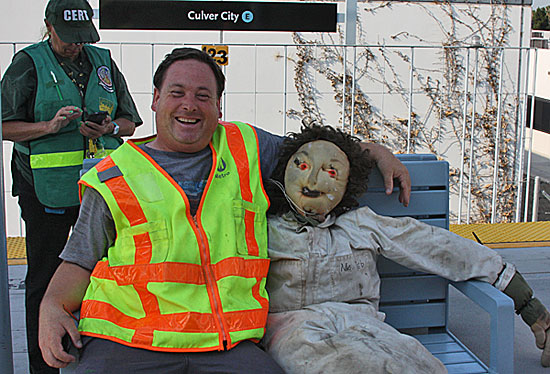
Dwight Sturtevant, aka Expo Line Fan, on the other side of the camera with Metro's crash dummy, Ms. Deb.
By profession, he’s a television engineer. But when he dons a fluorescent yellow vest and picks up his Canon EOS 40D camera, Dwight Sturtevant transforms into…Expo Line Fan.
At least he did until this week.
After nearly three years of chronicling the second, final phase of the Expo Line light rail project down to the last rivet and rebar, Sturtevant is leaving town for a new job in Ohio—and leaving behind a project he has documented in thousands of images and nearly three dozen videos since 2010.
Through it all, Sturtevant has worked anonymously and without compensation, with public credit for his photos going simply to “Expo Line Fan,” if it was given at all. But now, at last, his story can be told.
“I am just a rail fan who has been unofficially the project photographer,” the prolific volunteer said recently as he took a break from packing for the move. “I’ve had a free hand.”
Using his own photo equipment and wearing a Metro safety vest and a hard hat he purchased himself, Sturtevant has become a familiar figure on construction sites all along the 6.6-mile stretch where work is now underway to extend Expo from Culver City to Santa Monica.
His photos have appeared on Metro’s blog The Source, on the project’s website, on Supervisor Yaroslavsky’s website, in construction trade journals and on his own voluminous photo-sharing site.
“We use his pictures even in our office. It’s just built so much enthusiasm,” said Skanska USA Civil Executive Vice President Mike Aparicio, who added that Sturtevant’s outlook on the project has rubbed off on the whole Expo team. “When they see that kind of enthusiasm, they just feed on it.”
“He’s done a great job of capturing key milestones and highlighting progress,” Gabriela Collins, Expo’s government/community relations manager, said in a statement. “We thank him for sharing his wonderful photos and wish him well!”
While others have chronicled Expo’s progress in photographs, “Dwight has taken more than anybody,” and got unique shots because of his access to the construction process, said Darrell Clarke, a founder and co-chair of Friends 4 Expo Transit, longtime advocates for the project. “I’ve enjoyed his passion for following the project,” Clarke said.
Since his photo odyssey began, he has regularly delivered his copious output to the contractor, Skanska USA, to the Expo Construction Authority and to the Metro Library’s archives. It adds up: “If you figure every week since 2010, 200 pictures every week—do the math. It comes out to a lot of pictures.”
His connection to the project began—as so many L.A. adventures do—with a search for an alternate route. He was commuting at the time between downtown Los Angeles and the airport area and started to use Flower Street and Exposition Boulevard to get home. “And that’s when I went, ‘Wow, they’re building a light rail project.’ ”
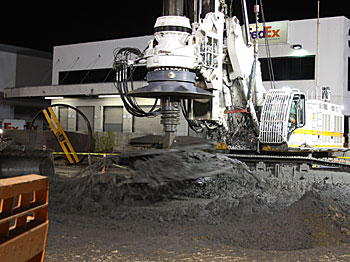
One of his favorites: time lapse shot of drilling for the Venice Boulevard Bridge. Photo/Dwight Sturtevant for Expo and Metro
When the company he was working for relocated to New Mexico, Sturtevant had more time on his hands and he was able to devote two days a week to photographing Expo.
“Over the last 2½ years, I’ve gotten the respect of Skanska where they’ve allowed me access to the project. Metro’s given me access to do certain things because I’ve earned the trust slowly, proved I wasn’t some nutcase,” he said.
He’s also become a familiar face to Metro’s train operators. For the past two years, he’s been printing up large posters with collages of his photographs to show them the project’s progress. He dropped off his last one at the 7th Street Metro Center last week, with a note: “To all my friends at Metro, I will miss you…I hope you have enjoyed the photos. Dwight S., aka the Expo Line Fan.”
Sturtevant, 51, said he has boyhood memories of looking at freight trains with his grandfather. His rail enthusiasm, literally, came with the territory: “I grew up in Boston. We had the first subway system in the country.”
His wife isn’t so keen on his hobby, however. He said her attitude is best summed up as: “If you’ve seen one train you’ve seen ‘em all.”
But he views his Expo work as a chance to make a difference, and to be an eyewitness to the construction of a light rail project that, in part, moves along the same route once traveled by the city’s late, lamented Red Cars.
“There’s not many places in the country where you’re able to watch cities regain what they’ve lost,” he said. “I mean, L.A. had all this once, and then we lost it.”
Sturtevant said he will be back for the project’s grand opening in 2015, and sooner if he can. In any case, the move to Ohio—where he’ll work for a mobile TV company that records professional sporting events—has at least one advantage for a train buff.
“The house has a big basement,” he said. “I’m going to be able to put my model railroad back up.”
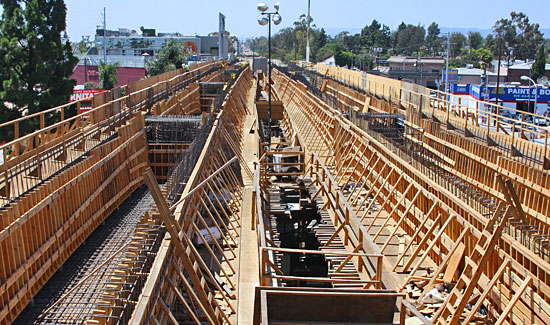
The Venice Boulevard Bridge, under construction last week. Photo/Dwight Sturtevant for Expo and Metro
Posted 8/13/13
End of the line for Expo legal challenge
August 7, 2013
A long-running legal challenge to the Exposition Line light rail project, now under construction from Culver City to Santa Monica, was stopped in its tracks this week by the California Supreme Court.
In a 6-1 decision, the court ruled against the group called Neighbors for Smart Rail, which contended in its lawsuit that the environmental reviews for the second and final phase of the Expo project had been inadequate.
The high court said the environmental information considered was sufficient, although they did agree with the plaintiffs on one point: they found that the project should have considered 2015 conditions—not 2030 conditions—in assessing potential impacts. But even so, the justices found, the process “did not deprive the agency or the public of substantial relevant information on those impacts.”
Expo backers hailed the ruling as the last chapter in a lengthy legal battle and said it clears the way for completion of the project, which will provide a transit alternative on a route that for the most part parallels the heavily-congested 10 Freeway.
“With this litigation now behind us, Westside residents can look forward to an exciting new public transit option when the Expo Line is scheduled to open in 2015,” Supervisor Zev Yaroslavsky, a member of the Exposition Light Rail Construction Authority board, said in a statement.
The high court ruling comes after two lower courts also rejected Neighbors for Smart Rail’s arguments. An injunction that would have stopped work on the project while the Supreme Court considered the group’s appeal was turned down in November, 2012.
Construction has been continuing at a brisk pace since then.
“We were free to move forward, and as a result we were able to construct about almost 50% of the project,” said Samantha Bricker, the construction authority’s chief operating officer. “The contractor is moving full steam ahead.”
“I think it’s a win for future riders,” she added, “as the project will be able to be delivered, as it stands right now, on time and on budget.”
Mike Eveloff, a board member of Neighbors for Smart Rail, said the group is continuing to explore its legal options.
“We’re in the weird position of being right on the law but I really think the court was hesitant to stop a big project,” he said. Meanwhile, he added, the organization “stands ready now, as we always have been, to talk about issues outside the legal process” to address its traffic concerns.
The initial phase of the Expo Line, between downtown Los Angeles and Culver City, opened last year to high ridership. When the second, final phase to Santa Monica is complete, Expo will make it possible to travel between downtown L.A. and Colorado Avenue and 4th Street in Santa Monica in 46 minutes.
Posted 8/7/13
Bill would spell it out, big time
July 18, 2013
Los Angeles transit and county officials have seen the proposed writing on the bus—and they don’t like it one bit.
A bill now under consideration in the state Assembly would require that signs—huge ones, in some cases—be placed on government vehicles driven by contractors to indicate that they are not government employees.
Michael Turner, the Los Angeles County Metropolitan Transportation Agency’s director of government relations, quipped that the sign amounts to a “scarlet letter” for contract employees.
On Tuesday, the Los Angeles County Board of Supervisors, acting on a motion by Supervisor Michael D. Antonovich, voted to oppose the legislation because of costs associated with installing the new messages. Metro’s Board of Directors will take up the matter at next week’s meeting. The San Diego Metropolitan Transportation System and the California Transit Association, which represents transit providers statewide, have already voiced their opposition as well.
The bill, SB-556, is being sponsored by state Senate Majority Leader Ellen Corbett (D-East Bay). According to a fact sheet from one of the bill’s co-sponsors, the California Labor Federation, the bill represents an attempt to reverse a trend toward increased use of contractors and temporary workers, who do not have the same benefits and protections as staff employees. It also aims to inform the public about who is providing services and who is accountable for them.
But for local officials and Metro, the devil is in the details.
As the bill currently reads, the following messages would be required on contractors’ uniforms and vehicles: “THIS IS NOT A GOVERNMENT EMPLOYEE” and “THE OPERATOR OF THIS VEHICLE IS NOT A GOVERNMENT WORKER.”
The font would have to be as large as the largest font otherwise displayed. Because logos are in large type, in Metro’s case that means the messages would be “as large as bus wrap ads, the ones that have the vehicles almost completely covered,” said Metro’s Turner. He said it would cost $1 million to install the signs, in addition to lost revenue from advertising that would otherwise occupy the space. Metro’s 148 contract buses currently display smaller messages to indicate they are operated by private companies.
Chris Patterson, the political director for the organization California Professional Firefighters, another co-sponsor of the bill, acknowledged that the language may need to be “tweaked.”
“This thing is not in final format by any stretch of the imagination,” said Patterson. “We left it intentionally vague so it can be changed as it goes through the process.”
“That said,” Patterson added, “we do strongly believe the public deserves to know who is showing up at their door and performing vital public services. We don’t see how more transparency would be bad.”
As the bill reads now, however, it would place a burden on transit providers—not just giants like Metro—but also smaller ones like the Topanga Canyon Summer Beach Bus and the Agoura Hills Dial-a-Ride.
“This seems a little overkill,” said Amy Brink, who manages the Agoura Hills service. “We are a small city so we have to contract out a lot of our services. We’re not large enough to have a full transit staff.”
Brink expressed concern that people who use her dial-a-ride—most of whom are seniors or disabled—would be confused by the signs.
“With all the details that are already required, I can’t imagine that they could fit anything more on there,” Brink said.
The bill was passed by the state Senate in May, and is slated for a floor vote by the full Assembly when the legislative body reconvenes from its summer break.
Posted 7/18/13
Bus lanes a peak event on Wilshire
June 4, 2013
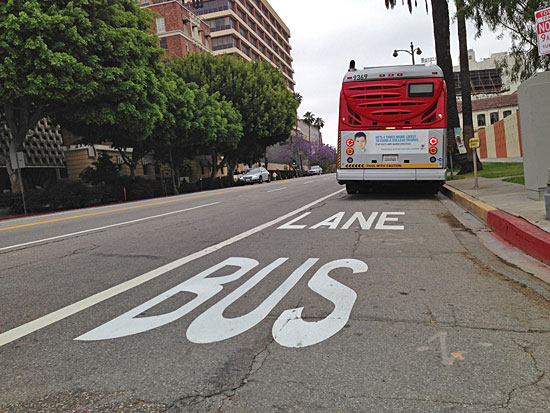
With the launch of a bus lane on Wilshire, a new chapter in the street's storied traffic history was opened.
Every two minutes during rush hours, Metro buses roll—or, rather, crawl—down Wilshire Boulevard, carrying tens of thousands of riders along one of Los Angeles County’s most clogged arteries.
But beginning Wednesday, those passengers may find a modest measure of relief from the blockage with a new 1.8 mile stretch of curbside bus lanes between MacArthur Park and Western Avenue. By late next year, according to Metro officials, the Wilshire Boulevard Bus Rapid Transit (BRT) lanes will span 7.7 miles—with a one-mile gap through Beverly Hills—ending at Centinela on the border of Santa Monica.
Metro predicts that the $31 million project could improve peak-hour travel times for riders by as much as 24 percent, or 15 minutes, between downtown and Santa Monica.
During a media briefing and ribbon-cutting on Tuesday, Metro board member and County Supervisor Zev Yaroslavsky, who’s long championed dedicated bus lanes, called the introduction of the Wilshire BRT’s first segment “a signal day for Los Angeles.”
With quicker, less stressful trips for bus riders, Yaroslavsky said, “there’s no question that their quality of life will be improved significantly.”
Yaroslavsky acknowledged that there’s been speculation and anxiety among some commuters over the potential traffic impact of eliminating a lane for cars in each direction during rush hours. “I hope people will give it a chance,” he said, then added: “I know they will.”
Dedicated bus lanes are seen as a crucial component in Los Angeles’ multi-faceted effort to reduce the region’s legendary traffic and encourage the use of mass transit—from subways to light rail to dedicated busways—all of which have increasingly been embraced by the public. Metro officials hope that the Wilshire Boulevard BRT will coax even more drivers out of their cars when they see a potentially faster alternative.
Metro’s project manager for the Wilshire BRT, Martha Butler, acknowledged that there could be some initial congestion in the “mixed use” lanes as drivers adjust to the famous boulevard’s new peak-hour realities. “But they’ll get more used to it,” she said, as the project progresses, one segment at a time.
Butler also said there’ll be “a grace period,” during which Los Angeles police officers will give warnings to drivers who improperly use the lanes on weekdays between 7- 9 a.m. and 4- 7 p.m. After that, they’ll get ticketed.
In all, the Wilshire BRT will encompass 12.5 miles, although only 7.7 miles will have designated bus lanes. The project, funded with a mix of federal and local monies, will also include street and signage improvements.
Before the Wilshire BRT project, the only other designated bus lanes in L.A. were along Figueroa Street from Adams Boulevard to 7th Street in the Downtown area. For more information, click here.
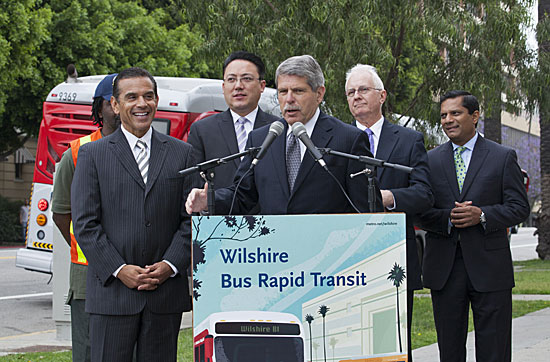
Supervisor Yaroslavsky said the first segment of the Wilshire bus lanes represented "a signal event in Los Angeles." Photo by Josh Southwick/Metro
Posted 6/4/13




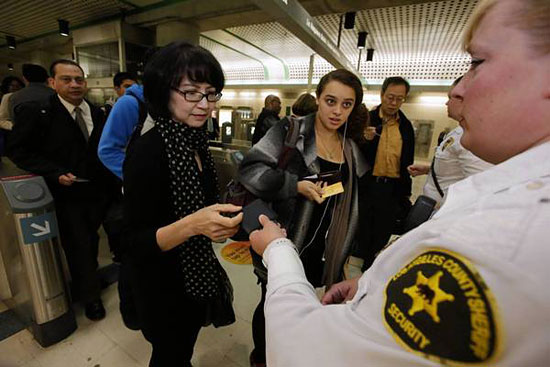
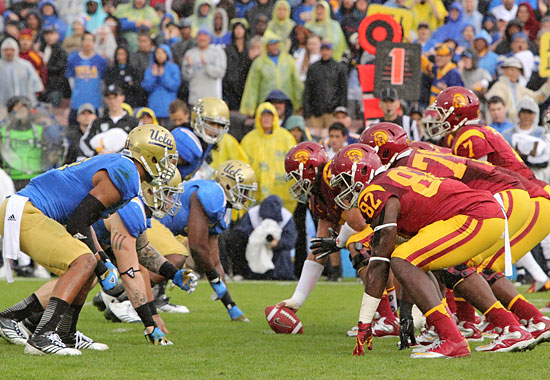
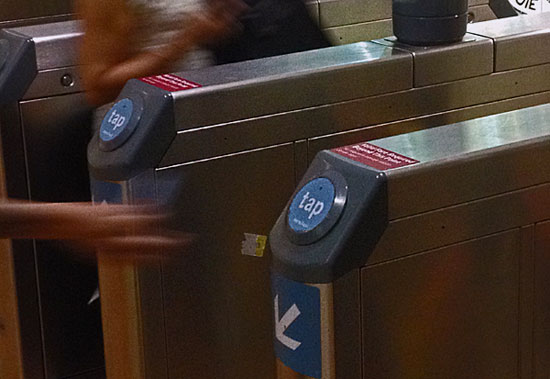
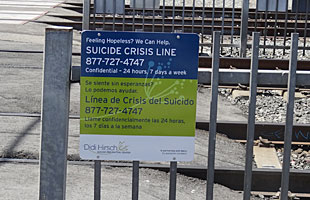
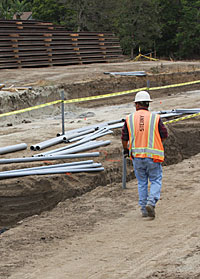
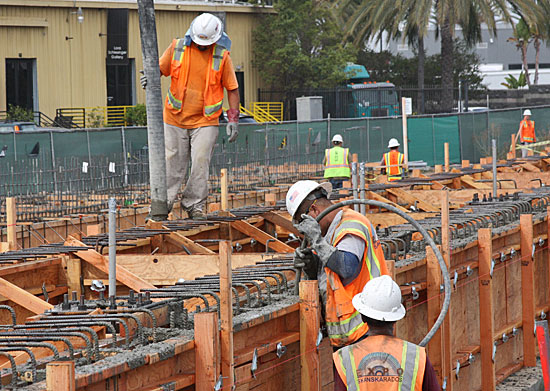
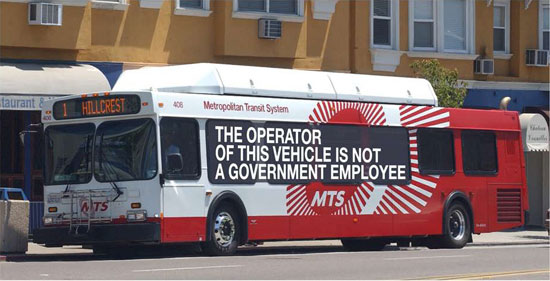







 405 bridge work causes a stink
405 bridge work causes a stink

